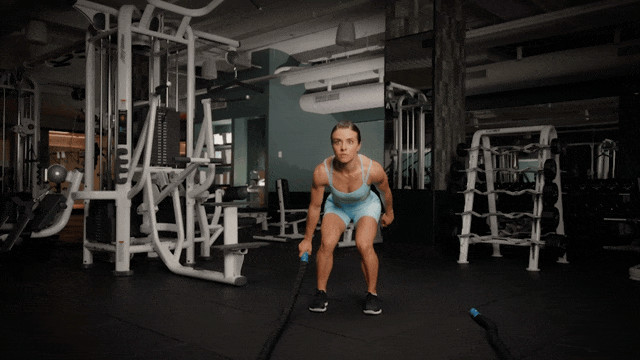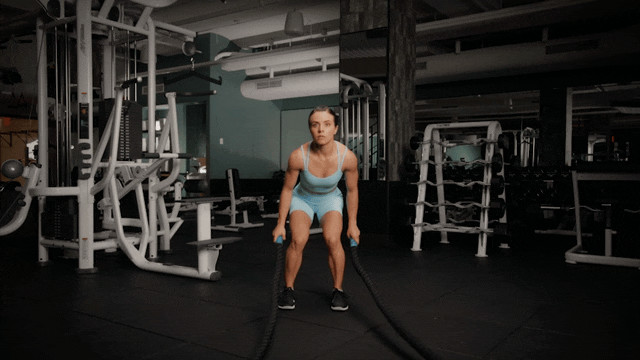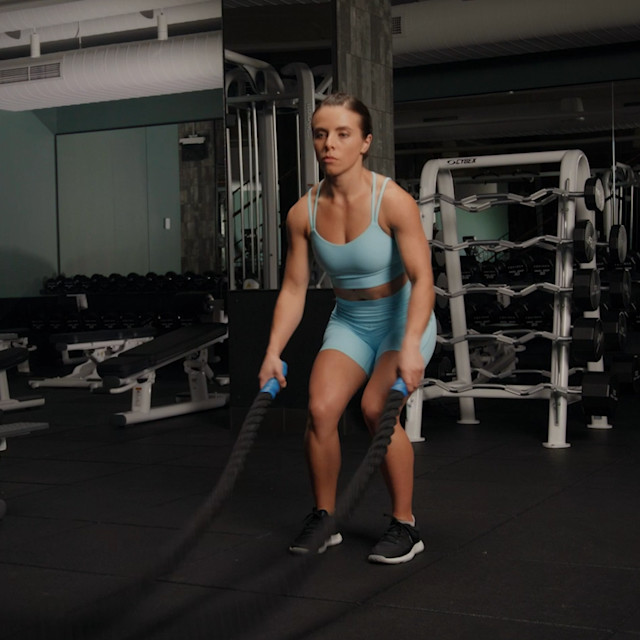Take your power and muscular endurance to the next level with this no-frills equipment.
Do More With is a series highlighting equipment around the Club that can help you reach your fitness goals. In this installment, we highlight the battle ropes, available on the Club floor.
Take a glance at someone using battle ropes at the Club, and there’s a good chance you’ll see them performing a “wave,” holding an end in each hand and flicking the ropes up and down, creating ripples in the rope as the energy moves toward the anchor point. It’s a classic, valuable movement to include in your training.
But one of the biggest benefits of battle ropes is their versatility — there’s so much more you can do with the equipment to elevate your fitness.
In case you’re unfamiliar, a battle rope is essentially a heavy rope anchored to a wall or looped around a fixed point. Some are short in length and thin, which makes it easy to establish baseline fitness and progress your exercises, while others are thick and long, which makes any movement a major challenge. Both can be used for a variety of moves that advance your muscular power and endurance, no matter your experience level.
Here’s my take on how you can get the most out of the bare-bones equipment the next time you’re in the Club, plus the reason why you should be using battle ropes in the first place.
Why Train with Battle Ropes
Though battle ropes look intimidating, anybody can use them, from beginners to the most advanced athletes. You can modify the fundamental exercises to make them more stable and controlled, but you can also progress them to challenge your body in multiple planes of motion and increase impact, the latter of which helps improve bone density. You can be standing still or be seated and get plenty of health benefits. Or, you can jump, shuffle, or jack as you move the ropes to increase the intensity. There are plenty of ways to make battle ropes work for you, your abilities, and your needs.

Primarily, battle ropes are going to train your ATP and glycolytic energy systems, since you’re going to be doing only short bursts of work, generating force as quickly as possible. I’m talking 90 seconds or less. When you complete these short, quick bursts of energy with battle ropes, you build up your resilience to higher-intensity work. Over time, that means you’ll be able to produce more power and move with greater explosiveness — and progress your cardiovascular fitness in the process.
RELATED: The Longevity Benefits of Power
That said, you can also use battle ropes to test muscular endurance (the ability to create and maintain force production for prolonged periods). You’ll still keep the efforts short, but you’ll pair them with other exercises that tax similar muscle groups into a hard-hitting circuit. The better your muscular endurance, the longer you’ll be able to work without feeling winded.
How to Use Battle Ropes

The biggest mistake you can make when using battle ropes is going in without a plan. It’s really important to understand what you’re hoping to achieve with the equipment and then program around that goal.
Want to build power and explosiveness? Bilateral waves are your go-to. Stand with your feet nice and wide, holding the end of each rope in your hands and keeping your elbows tucked into your sides. Simultaneously slam both ropes down to the ground in one sweeping motion, then flick them back up. You’ll want your rating of perceived exertion to feel like an eight out of 10 with this exercise — but you’ll be performing the move for only 10 to 20 seconds before resting. To switch it up, try slamming just one rope at a time, alternating arms but keeping the movement consistent, which challenges your stability.

For an intermediate exercise, I love the overhead slams; as the name implies, you’re reaching overhead and slamming the ropes to the floor as hard as you can, with or without jumping. It’s similar to a med ball slam in that you’re using your full body’s power to drive your arms toward the ground. When you’re ready for a serious challenge, try making figure-eights with your hands while holding the rope ends or creating a wave with just one arm — while you’re holding a high plank or stepping back into a reverse lunge. You’ll work your core, lower body, and upper body in one fluid motion.

With a power focus, you’ll generally want to place your battle ropes exercises at the beginning of your workout, when your nervous system isn’t yet fatigued. You don’t want to have already done a 45-minute strength workout and then try to work on your power output; you won’t be getting the most out of your training and giving your body the best chance at progressing.
For an endurance session, incorporate battle ropes into a circuit. You might do an agility exercise, a ViPR exercise, a muscular-endurance dumbbell movement, and then end the round with a battle ropes move. It’ll increase your workload and heart rate and burn out your muscles. Make sure to give yourself enough time to catch your breath in between rounds, but not too long that your heart rate completely recovers. Alternatively, you can train your endurance with battle ropes at the end of your workout. It’s the opposite thinking of training your power: You want your nervous system to be taxed. The exercises will be moderate intensity — a six or seven out of 10 RPE — for 20- to 30-second work periods.
RELATED: Do More With: The ViPR PRO

Most people hold onto both ends of the rope, but you can detach the rope so it’s freestanding and perform some pretty innovative exercises. For example, you can tie a heavy kettlebell to one end of the rope and then pull the weight toward you, almost like a solo tug-of-war match. It’s a type of rowing exercise that’s more intense than you’d expect.
Good posture and core engagement are the two elements I see fall to the wayside when members use battle ropes on their own. It makes sense: Battle ropes are a really challenging piece of equipment, and people want to put every ounce of effort into conquering it. But in doing so, they end up flailing with their upper body. My advice? If you need to regress the exercise a little bit or dial back your intensity, do so. That will give you the space to focus on standing upright, stabilizing your core, and avoiding unnecessary rotation through the hips and upper body — and ultimately ensure you get the most out of your workout.
It seems old-school, but don’t overlook the value of a timer when working with battle ropes. I often see members going all-out without a specific time set for their work-to-rest intervals; they work until they hit failure, don’t rest enough, then run out of gas too soon to see any potential benefit from their training later. A good set-up: Create a timer on your phone for 10 seconds of work and 60 seconds of rest, and repeat three to four times.
So long as you walk into the Club with an intention for your battle ropes work, actually consider it as you plot out your workout for the day, use a timer, and constantly check in with your RPE, you’ll be golden.
Ali Packowitz has been a Coach at Equinox Gold Coast in Chicago for almost eight years. She has a Master in Nutrition Education and is a USA Triathlon Coach. Ali's journey into the fitness industry was driven by her love for understanding how nutrition fuels performance and the transformative power of endurance and strength training.
